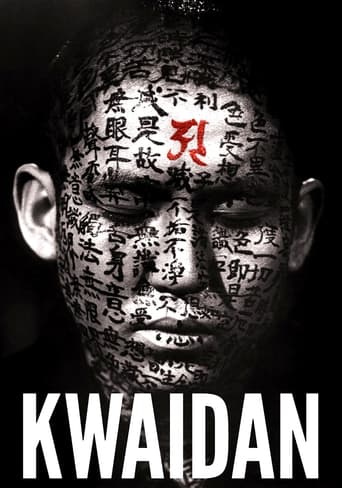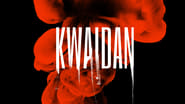Osmosis Iron
If you value visual style, good folk tales(of horror) and don't shy away from graphic scenes and unsettling themes, this movie needs to enter your watch list now! This collection of Japanese folk tales has been brought to life with sublime style! Everything from visuals, score, atmosphere and pacing is crafted stupendously to fit the story and maximize the impact each tale provides. I'd say the visuals alone are worth the watch, but the stories are also great! See for yourself, and be happy you didn't miss this gem!
theFoss
Watched this one on Hulu's Criterion Collection...It was interesting enough, but seemed uneven, to me...Black Hair, the lead vignette, as others had mentioned, bogged down, IMO, with the Samurai horse archery scene, before reeling to its Gothic ending...Woman of the Snow was both interesting and beautifully filmed, with its watercolor panoramas, separating the outdoor scenes, SPOILER ALERT, its ending was not quite what I expected, with Yuki's mother instinct, apparently, not wanting to orphan her children.Hoichi the Earless, kicks off with a genuine, and reasonably accurate depiction (even down to the blackened teeth of the Heike!) of the Battle of Dan-no-ura, a pivotal sea battle (in the Samurai style, where ships were just platforms for infantry and archers) of the Genpei War of 1180-1185, that ushered in the first Shogunate, as the Genji (Minamoto) clan defeated the Heike (Tiara)Clan. Emperor Antoku, a 6 year old descendant of the Heike was drowned by his grandmother, who jumped into the Shimonoseki Strait with the child Emperor in her arms, rather than allow him to be captured by the Genji, following the mass suicide, by drowning, of many of the Heike clan, when defeat seemed inevitable...a brief cut that shows the Heike crabs, whose shells seem to have a warrior's face, significance is often lost on western audiences, unfamiliar with Japanese history and beliefs...After the battle, superstition held that the faces on the crabs reflected the spirits of the drowned Heike warriors, the "ghosts" that call Hoichi to play at Emperor Ankotu's court...my feeling is that the long setup, and brief epilogue, makes the "payoff" of this tale a little disappointing, but reading other accounts, there seems to be an extended version of this section, that highlights the Biwa playing, and ties ends up better, but, on the Hulu version, that I watched, the ending seems a bit abrupt...Also, IMO, Hoichi lacks the cinematic flair and beauty of the "Black Hair" and "Woman of the Snow"Finally, In a Cup of Tea, a story about telling an unfinished story, examining the consequences of drinking another's soul, that for reasons inexplicable (or incomprehensible to me), seems to reside in a cup of tea. As I speak none of the language, and had to depend on subtitles, I didn't completely understand this tale. It appeared, to me, more of a tale of madness and delusion, rather than a "supernatural" event as it wound down to its , shockingly, ironic conclusion, SPOILER ALERT! involving the author of the story...also, the visuals, lacked the boldness and beauty of the first two vignettes...This is the third film by Kobayashi I have seen, and would place it behind Seppuku (Harakiri) and Samurai Rebellion, as far as story telling, perhaps simply because they are more focused tales, rather than a collection of short stories, although, the Gothic horror of Black Hair, and the stunning outdoor scenes of Woman of the Snow, are superior to the other films mentioned, visually.In summary, Kaidan seems more an interesting experiment, that reminded this viewer of Twilight Zone or Night Gallery quality stories, with more attention to visuals than the aforementioned TV shows.
MortalKombatFan1
This horror anthology made by Toho Studios in the 1960's is one of the more beautiful and eerie than it is scary. Based on four Japanese folk tales, the film has an air of artifice about it, using colourful lighting (which changes mid-scene for supernatural effect), fancy period costumes and makeup, and massive set-pieces (wheat fields and show covered forests are reproduced on the stage, an elaborate sea battle is shown against a painted backdrop). It was one of the most expensive movies made in Japan at the time, and it shows. With so much style, it could be said that the film is an exercise in excess, but really, the style lends itself perfectly to each story, and makes the images from these old tales fresh and unique even fifty years on.The first story, "Black Hair" shows a man leaving his wife to pursue wealth in the city by re-marrying the daughter of rich clan. He is happy at first, but when he thinks back about the woman he loved which he abandoned, revisiting their old abandoned homestead haunts him, literally. In "The Woman and the Snow", two men are stuck in a snow storm, and after his partner freezes to death at the hands of spirit in the form of a woman, he sees her and is spared. She tells him to never speak of seeing her to anyone and he can live. He does for a time, and meets a girl in a nearby village who looks suspiciously like her, only to fall in love with her and raise a family. After an intermission, the longest segment, "Hoichi, the Earless" follows. A blind minstrel, Hoichi, plays a song on the biwa about a fierce sea battle between two clans that ends in the death of a child emperor and his servants, who kill themselves by jumping overboard, rather than being captured by the enemy. Later, Hoichi is called upon by a ghost of the clan to come up upon a mountain top and sing their story to them forever. His disappearance from the monastery is noticed, and some monks are sent out to find him.The final story, "In a Cup of Tea", is an unfinished tale that acts as a coda to the film, being about an writer that must finish a story in time for his publisher and writes one about a man who drinks a cup of tea with the face of person in it. The person in the tea comes to life and visits him at his home over several nights, once by himself and then another time sending his guards. Only the tea drinking man can see the apparitions, which disappear and reappear every time he strikes them in fear. Does he go mad in the end? It is never said. It shouldn't work as an ending, but it does.Each tale acts as a sort of morality play, warning against the dangers of following strangers, or being mislead by women. They're deeply entrenched in folklore and eastern mysticism, and the grandiose camera work and haunting score by Toru Takemitsu make "Kwaidan" a very fine, if stately paced, ghost story anthology. The best segment is "Hoichi, the Earless", with its elongated prologue which is entirely sung by the main character, explaining the story to follow. "The Woman and the Snow" is a sort of love story which is beautiful and sort of tragic, and "Black Hair" has a justifiably bitter conclusion, which is also the scariest of the films.
Leofwine_draca
KWAIDAN is a Japanese anthology of four ghost stories, each based on an original story by Lafcadio Hearn originally written at the turn of the 20th century (I've read some of those stories, and they're well worth checking out if you're a literature fan, by the way). The initial story explores the fate of a man who leaves his loving wife, only to end up regretting his decision. I found this story to be a bit overlong – there's only so long you can drag out something when nothing's happening – but lovely to look at and exceptionally spooky, along the same lines as a similar '60s classic, ONIBABA.The second story tells the tale of a vengeful snow spirit and is equally spooky, with some great hand-painted sky backdrops. Again, it's overlong, and the ending is something of a letdown, but the tale works as a whole and contributes to the icy atmosphere of the production. The third story is where things start to lose steam. It starts off promisingly enough, with a fine depiction of an epic sea battle, but then it goes absolutely nowhere with the plotting. The story is dragged out for a full hour – sometimes whole dialogues are repeated – until the admittedly decent climax.The final story, about a haunted cup of tea, works far more effectively than it sounds. It's of a far better length (read: shorter) and all the more effective because of that. Sadly, despite this film's beauty and visual artistry it does end up being way too long (at over three hours) and just too slow-moving for my taste, so I didn't enjoy it as much as I'd hoped. Certainly not a patch on ONIBABA: now that was a great movie!





